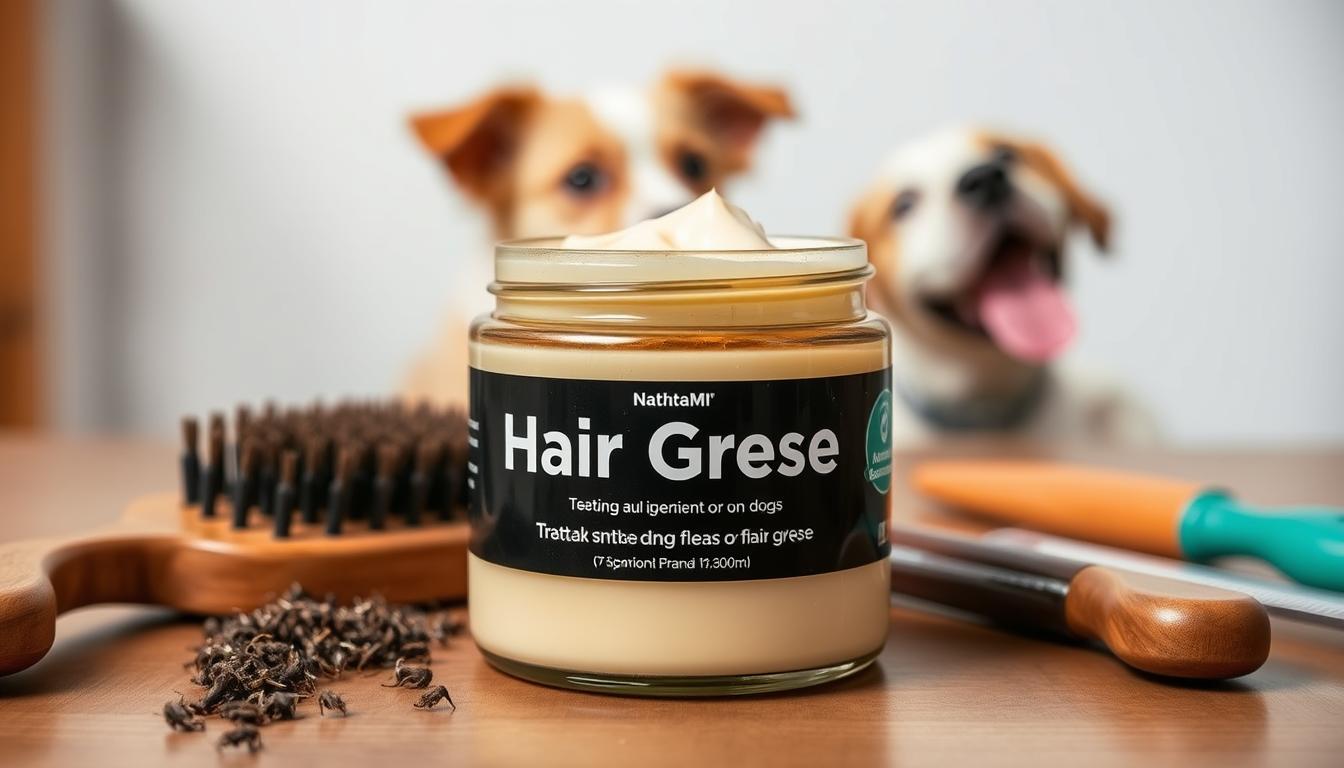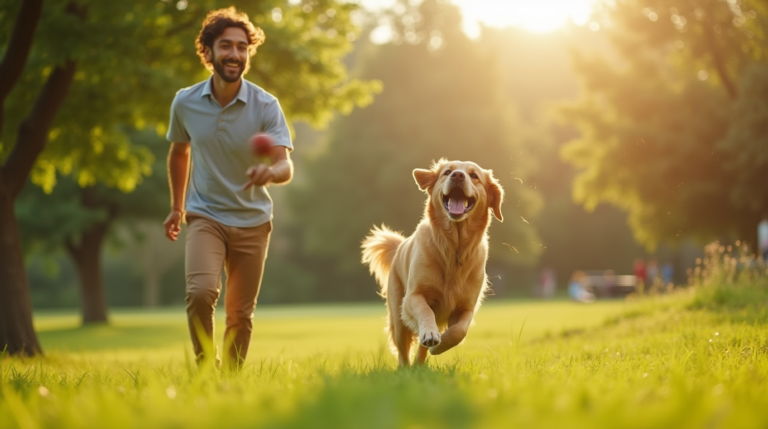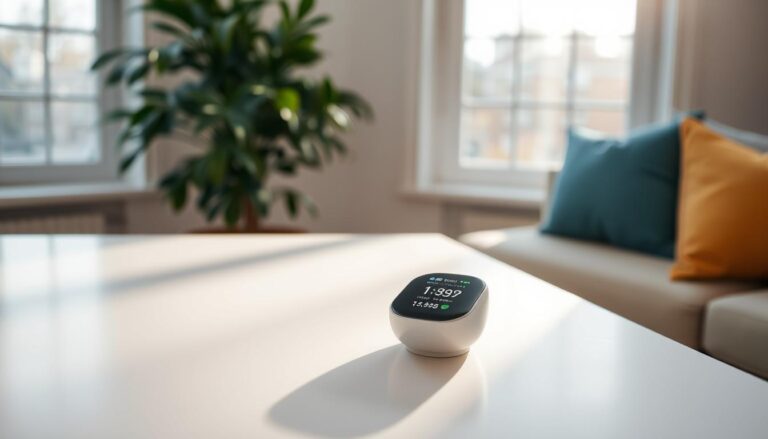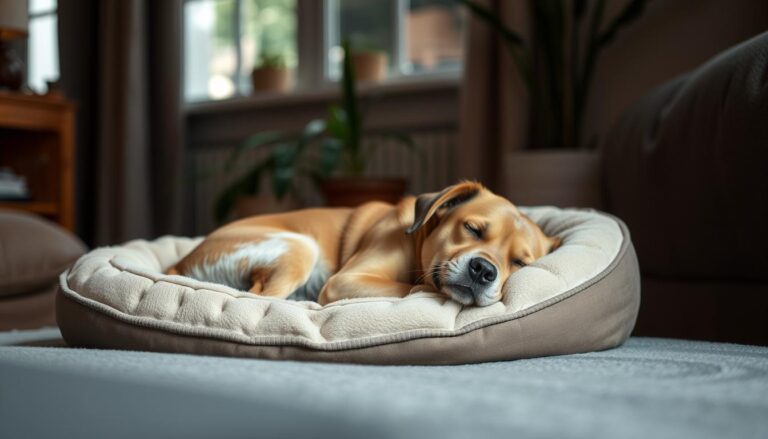As a devoted pet parent, I’ve battled fleas many times. The constant scratching and unwanted guests in your home are stressful. But, I found a secret weapon: hair grease for flea control.
Hair grease is effective, safe, and easy to use. It’s a natural solution that can change the game against fleas. It not only kills the fleas but also prevents new ones from coming.
Table of Contents
Identifying Flea Infestations in Dogs
Spotting the signs of a flea infestation is key to treating and stopping these pests. From more itching and scratching to finding flea dirt, knowing the signs helps you act fast. Let’s look at the signs of fleas on dogs.
Signs of Fleas in Pets
- Intense itching and scratching, especially around the base of the tail, belly, and hind legs.
- Visible flea dirt – tiny, dark specks that resemble ground black pepper.
- Excessive grooming and licking, which can lead to hair loss and skin irritation.
- Seeing fleas themselves on your dog’s skin or in their fur.
- Presence of flea bites – small, red bumps on the skin.
Using a fine-toothed flea comb can help find and remove these pests. Checking for flea dirt confirms an infestation. It’s important to tackle flea problems quickly to stop them from getting worse and to keep your dog comfortable.
“A single adult dog flea can lay between 20 to 50 eggs a day, leading to rapid escalation of infestations.”
By being alert and knowing the signs of fleas on dogs, you can protect your dog from fleas. This keeps them happy, healthy, and flea-free.
Understanding the Health Risks of Fleas
Fleas can be a big problem for dogs and their owners. These tiny pests can spread flea-borne diseases like tapeworms and the dangerous Bartonella bacteria. A bad flea infestation can even cause anemia in puppies or small dogs. For people, flea bites can lead to itching, allergic reactions, and flea allergy dermatitis.
Fleas carry bacteria that can cause serious illnesses. These include murine typhus and plague. Lyme disease, spread by ticks, can harm the joints, heart, and nervous system if not treated.
| Health Risk | Symptoms | Potential Consequences |
|---|---|---|
| Flea-borne diseases | Tapeworms, Bartonella | Intestinal issues, bacterial infections |
| Anemia | Lethargy, pale gums, weakness | Decreased oxygen circulation, organ damage |
| Flea allergy dermatitis | Severe itching, skin irritation | Uncomfortable skin conditions, risk of secondary infections |
| Murine typhus | Fever, headache, rash | Potentially serious bacterial infection |
| Plague | Fever, chills, swollen lymph nodes | Life-threatening bacterial disease |
| Lyme disease | Bull’s-eye rash, joint pain, fatigue | Spread to joints, heart, and nervous system |
It’s important to tackle a flea problem quickly to keep pets and owners safe. Talking to a vet and using prevention can help avoid these health risks.
Natural Flea Repellents and Home Remedies
Think about using flea repellents for dogs that are natural and homemade. Smells and substances like essential oils, apple cider vinegar for fleas, and homemade flea sprays can keep fleas away. These natural flea control methods can make your home safer for your pets.
Natural Smells and Substances Fleas Hate
Fleas don’t like many natural smells. These smells can be great repellents. Here are some of the best:
- Essential oils like lavender, eucalyptus, and peppermint
- Diluted apple cider vinegar
- Lemon spray
- Baking soda
- Brewer’s yeast
- Rosemary
- Neem oil
You can add these to your pet’s grooming or make homemade flea sprays for your home. This will help keep fleas away.
“Over a year of testing, the author found 5 most effective natural flea repellents for dogs after experimenting with various sprays, creams, soaps, and diets.”
Always dilute essential oils and use them carefully. Some, like tea tree oil, can harm pets if used too much.
Grooming Techniques for Flea Removal
Keeping your dog flea-free can be tough, but the right grooming can help. Flea combing is a top method. It uses a fine-toothed comb to remove fleas and their eggs from your dog’s fur. This lets you check your pet’s coat well and find fleas in their favorite spots.
Bathing your dog is also key in fighting fleas. Use a gentle, pet-safe soap to kill fleas and remove eggs and larvae. But, don’t over-bathe your dog. This can harm their skin and cause irritation.
Regular grooming of your pets is vital for a flea-free home. Brushing your dog and checking their skin can spot flea problems early. This stops big flea issues and keeps your dog happy and healthy.
| Grooming Technique | Benefits |
|---|---|
| Flea Combing | Physically removes adult fleas and eggs |
| Bathing with Mild Soap | Drowns and washes away fleas, eggs, and larvae |
| Regular Grooming | Helps identify and address flea infestations early |
For a complete flea fight, use grooming, treatments, and vet-approved preventatives. This mix keeps your dog happy, healthy, and flea-free.
“Groomers are often experts at finding fleas and performing ‘flea funerals.'”
hair grease for fleas on dogs
Using hair grease for fleas on dogs is a surprising way to fight fleas. The greasy texture of pet-safe hair grease products makes it hard for fleas to move around on your dog’s coat. When applied right, hair grease can kill adult fleas and stop the flea life cycle.
How to Apply Hair Grease for Flea Control
To use hair grease as a flea treatment effectively, follow these steps:
- Begin by brushing your dog’s coat well to remove loose hair, dirt, or debris. This helps the hair grease reach the skin.
- Put a small amount of pet-safe hair grease on your hands and gently rub it into your dog’s coat. Focus on areas fleas like, like the neck, belly, and tail base.
- Make sure to spread the hair grease all over your dog’s fur for full coverage.
- Let the hair grease stay on your dog’s coat for at least 30 minutes, or as the product says.
- Then, rinse the hair grease off with warm water. Be careful to get rid of all traces on your dog’s skin and fur.
- Do this again as needed, usually every 7-10 days, to keep fleas under control.
Always choose pet-safe hair grease products made for dogs to keep them safe and comfortable.
“The greasy texture of hair grease can make it difficult for fleas to navigate and thrive on your dog’s coat, effectively smothering and killing adult fleas.”
Prescription Flea Treatments for Dogs
Natural remedies can help with mild flea problems. But, for serious cases, stronger treatments are needed. Your vet can suggest veterinary-recommended flea medications, prescription flea collars and chews, and FDA-approved flea products for pets. These are made to kill adult fleas and stop their life cycle.
For effective flea and tick prevention, consider Simparica Trio. It’s for dogs as small as 2.8 pounds, starting at 8 weeks old. It fights fleas, ticks, heartworm, hookworm, and roundworm with three active ingredients. It’s also priced well compared to other options.
| Product | Active Ingredients | Coverage | Minimum Age | Frequency |
|---|---|---|---|---|
| Simparica Trio Chewable Tablets | Sarolaner, Moxidectin, Pyrantel Pamoate | Fleas, ticks, heartworm, hookworm, roundworm | 8 weeks | Monthly |
It’s important to use flea and tick preventatives regularly. These pests can quickly come back. Your vet will choose the best prescription flea treatments for dogs based on your dog’s needs.

Keeping fleas and ticks under control is vital. They can spread diseases like anemia and Lyme disease. Working with your vet ensures your dog gets the best FDA-approved flea products for pets to stay healthy and happy.
Treating Your Home for Fleas
Dealing with fleas means tackling the problem in your home as well as on your pet. Fleas can live in carpets, rugs, and soft furniture, laying eggs and starting the cycle again. To get rid of fleas in your home, follow this guide.
Vacuuming to Remove Fleas
Vacuuming often is key in fighting fleas at home. Fleas, eggs, and larvae hide in carpets and rugs. Vacuuming can cut down flea eggs by 60% and larvae by 30%, making it a vital part of your flea battle plan.
Using Flea Sprays for Carpets and Furniture
Using flea sprays on carpets, furniture, and other soft spots can kill adult fleas and break the cycle. Choose EPA-approved flea sprays that are safe for pets and kids.
Applying Diatomaceous Earth for Fleas
Diatomaceous earth is a natural way to fight fleas. Sprinkle it around your house. This powder dries out and kills flea eggs and larvae. Wait 24-48 hours before vacuuming it up.
| Flea Control Method | Effectiveness |
|---|---|
| Vacuuming | Reduces flea eggs by 60% and larvae by 30% |
| Flea Sprays | Kills adult fleas and disrupts the life cycle |
| Diatomaceous Earth | Dehydrates and kills flea eggs and larvae |
By taking these steps, you can treat your home for fleas and make it flea-free for you and your pet.
Maintaining a Flea-Free Environment
Getting rid of fleas is just the first step. Keeping your home and yard flea-free is crucial to avoid future problems. Use flea prevention on your dog all year, vacuum and wash bedding often, and keep your yard clean. This proactive approach will protect your pet and home from fleas.
Regular grooming can cut down flea infestations by up to 70%. In homes with many pets, flea transmission between them is 50% higher. Using flea prevention products correctly is key, as they work in over 90% of cases.
Dogs that spend more than six hours outside are 3 times more likely to get fleas. In warm places like Florida, fleas are active all year. Check your dog for fleas, especially in warm spots like the ears and belly. Watch for signs like scratching, hair loss, or fleas despite treatment, and see a vet if needed.
Many dog owners use flea shampoos, treatments, and collars. But 30% also use natural remedies. Keep your home clean by vacuuming often, washing pet bedding in hot water weekly, and getting professional help if fleas come back.
By following these steps and staying alert, you can keep your pet and home flea-free. This will make your pet happy, healthy, and free from flea discomfort and health risks.

| Flea Prevention Strategies | Effectiveness |
|---|---|
| Regular use of flea control products | Over 90% successful in preventing infestations |
| Maintaining a clean home environment | Crucial to preventing recurring flea problems |
| Frequent grooming | Decreases likelihood of flea infestation by up to 70% |
| Veterinary check-ups | Result in early detection of flea issues in 85% of cases |
“Maintaining a flea-free environment is essential to preventing future infestations and ensuring the health and comfort of your pet.”
When to Seek Veterinary Assistance
Dealing with fleas on your dog can be tough. Sometimes, you need a vet’s help. Look out for signs like lethargy, weight loss, pale gums, or tapeworms. If you see these, it’s time to visit your vet.
Your vet can give your dog the right treatment. They can also check for other health issues. They know the best ways to keep your dog safe from fleas.
- Fleas can spread diseases like typhus, plague, and tapeworms to pets and people.
- A bad flea problem might need your pet to have daily baths.
- You might find flea dirt, looking like salt and pepper, in your pet’s bedding.
While you can handle some flea problems at home, ignoring serious signs can cause more harm. Getting vet help when needed keeps your dog healthy and your home flea-free.
“One female flea can lay up to 2,000 eggs, and it can take as long as three to four months to get rid of a flea infestation in a home.”
Fleas or ticks can appear any month of the year. So, always be ready to prevent them. With the right steps and vet advice, your dog will stay happy and flea-free.
Conclusion
To manage a flea infestation on your dog, you need a mix of treatments. Using hair grease, natural repellents, and grooming helps protect your dog. This keeps them healthy and happy.
It’s important to tackle fleas holistically. Talk to your vet about the best treatments for your dog. Also, keep your home clean and use safe products like Diatomaceous Earth. This helps fight fleas effectively.
As a pet owner, it’s vital to stay alert and follow a flea prevention plan. Use hair grease, natural remedies, and regular maintenance. This way, you can avoid the dangers of fleas and ticks. Your dog will live a happy, healthy life without fleas.
FAQ
What are the signs of a flea infestation on my dog?
What health risks do fleas pose to my dog?
What are some natural flea repellents I can use?
How can I use hair grease to treat fleas on my dog?
When should I seek veterinary assistance for a flea problem?
Source Links
- Yes, you can get fleas from your pets — and they can get fleas from you. Here’s how to prevent them – https://www.nbcnews.com/select/shopping/how-get-rid-fleas-ncna1262654
- The 6 best flea and tick treatments for dogs in 2024 – https://www.businessinsider.com/guides/pets/best-flea-treatment-dogs
- The Complete Guide to Flea and Tick Prevention and Treatment for Dogs – https://www.petmd.com/dog/general-health/flea-and-tick-prevention-and-treatment-dogs
- Is Your Dog Scratching? It Might Be Fleas! – https://cyfairanimalhospital.com/blog/dog-fleas-signs-treatment/
- How To Tell if Your Dog Has Fleas? (5 Important Signs) – Today’s Homeowner – https://todayshomeowner.com/pest-control/guides/how-to-tell-if-your-dog-has-fleas/
- Everything You Need to Know About Flea Dirt in Dogs – https://banixx.com/everything-you-need-to-know-about-flea-dirt-in-dogs/?srsltid=AfmBOoqyozZGDXoWEsiq99TGT8GHmI-lVj0u2klN9SQdkDtlhvE0z8Ac
- Flea and Tick Medicine Poisoning in Dogs – https://www.petmd.com/dog/poisons/flea-and-tick-medicine-poisoning-in-dogs
- Understanding the Health Risks of Fleas and Ticks in Outdoor Environments – https://nexgreen.com/understanding-the-health-risks-of-fleas-and-ticks-in-outdoor-environments/
- 11 Home Remedies for Fleas and Ticks That Actually Don’t Work – https://www.petmd.com/parasites/flea-and-tick-treatments-that-dont-work
- 5 Natural Flea Repellents For Dogs and Cats – https://whatgreatgrandmaate.com/5-natural-flea-repellants/
- 9 Natural Flea Remedies for Cats and Dogs – https://www.treehugger.com/natural-flea-remedies-cats-and-dogs-4864286
- Do Groomers Remove Fleas? Get the 411 on Flea Grooming Services – https://be.chewy.com/how-to-get-rid-of-fleas-on-your-dog-or-cat-during-their-grooming-routine/
- How to Get Rid of Fleas on Dogs (Remedies and Treatment) – https://www.honestpaws.com/blogs/health/natural-flea-killers
- 6 Ways to Rid Your Pet of Fleas – wikiHow – https://www.wikihow.com/Rid-Your-Pet-of-Fleas
- Homemade Flea Shampoo for Dogs – Whole Dog Journal – https://www.whole-dog-journal.com/care/homemade-flea-shampoo-for-dogs/
- How to Use Coconut Oil for Flea and Skin Treatment on Dogs – https://www.wikihow.com/Use-Coconut-Oil-for-Flea-and-Skin-Treatment-on-Dogs
- The 6 best flea and tick shampoos for dogs, recommended by a veterinarian – https://www.businessinsider.com/guides/pets/best-flea-tick-shampoo-dogs
- The Best Flea and Tick Treatments for Cats and Dogs – https://www.nytimes.com/wirecutter/reviews/best-flea-treatment-cats-dogs/
- The 8 Best Flea and Tick Medications for Dogs in 2024, Recommended by Vets – https://www.petmd.com/dog/vet-verified/best-flea-tick-medications-for-dogs
- How to Get Rid of Fleas on Dogs, Naturally – 9 Best Home Remedies For Fleas – https://www.kinship.co.uk/dog-health/how-get-rid-fleas-dogs-naturally
- Are Home Remedies Effective for Fleas on Dogs? Our Vet Explains – Dogster – https://www.dogster.com/ask-the-vet/home-remedies-for-fleas-on-dogs
- How to Keep Fleas Off Your Dog in Florida – https://www.nativepestmanagement.com/blog/2024/june/how-to-keep-fleas-off-your-dog-in-florida/
- An Inside Scoop to Keeping Your Dog Free of Fleas – American Dog Society – https://americandogsociety.com/an-inside-scoop-to-keeping-your-dog-free-of-fleas/
- A Guide on How to Remove the Pests From Fur – https://www.webmd.com/pets/remove-fleas-from-pet
- No title found – https://www.akc.org/expert-advice/health/how-to-get-rid-of-fleas/
- Preventing and Treating Fleas and Ticks For Dogs – https://www.4pawsanimal.com/services/dogs/parasites/flea-and-tick-for-dogs
- Preventing Fleas & Ticks on Pets: 4 Protective Tips | BetterVet – https://bettervet.com/resources/pet-health-care/flea-and-tick-prevention
- Combat Fleas & Hair Loss in Dogs Effectively | Mavyn – https://www.mavyn.com/blog/combat-fleas-hair-loss-in-dogs-effectively








1 thought on “Effective Hair Grease for Fleas on Dogs: Quick Guide”
Comments are closed.